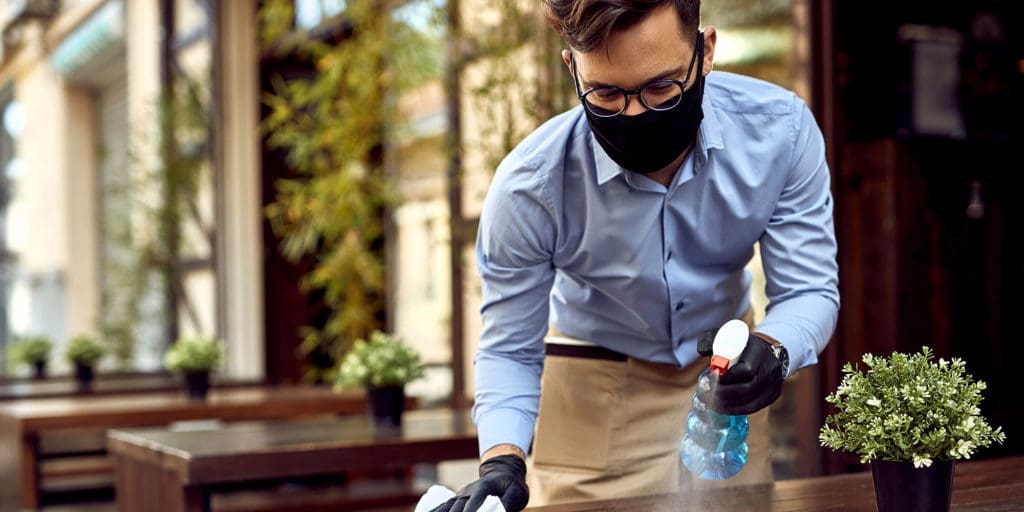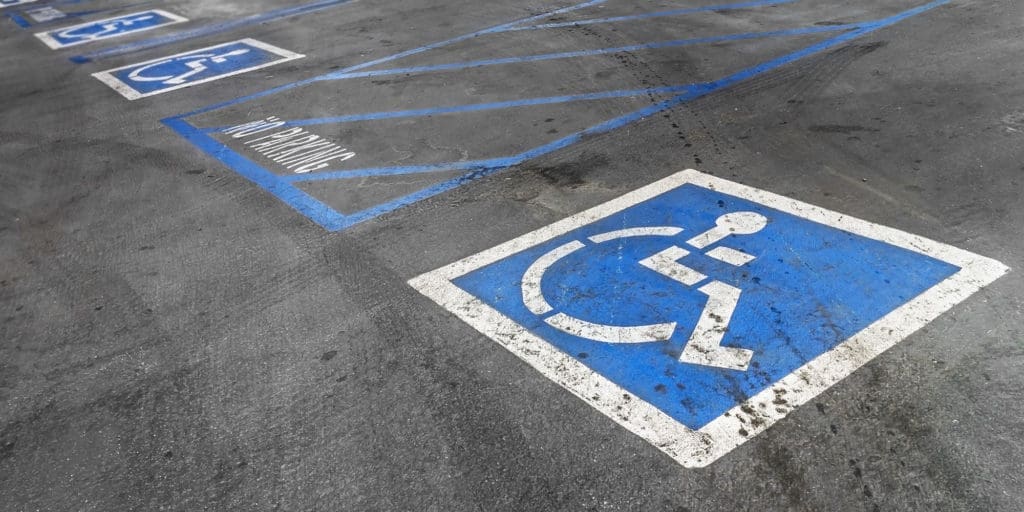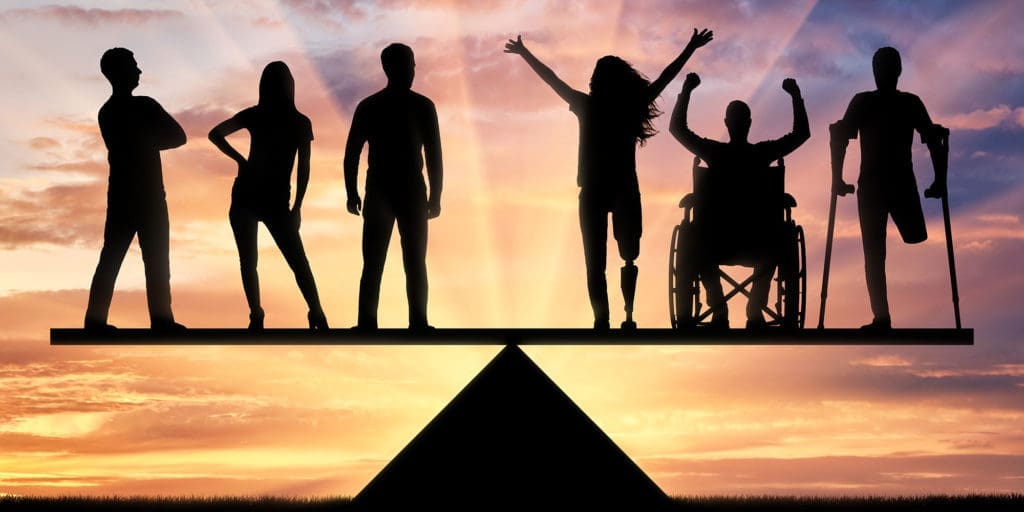One common talking point throughout the pandemic has been that, “We’re all feeling the effects of the pandemic.” And that’s true; with very rare exceptions, life is harder for everyone due to coronavirus. However, exactly how bad it is and how it affects you can be largely dependent on your physical ability.
As the spread of COVID-19 continues, many individuals and businesses are making decisions that benefit the majority at the cost of people with chronic pain. Today, I’d like to talk about the significance of these seemingly innocuous offenses and take a look at why now is the best time for able-bodied people to consider the full effects of their actions.
 The Infamous Outdoor Tables
The Infamous Outdoor Tables
If you’ve been active around the internet lately, there’s a good chance you’ve heard about the debacle surrounding restaurants trying to adjust to new safety standards. Often, these struggling businesses will let outdoor seating spill onto the sidewalk as a way to keep serving customers while enjoying the benefits of air ventilation in minimizing the risk of COVID spread.
At first, the logic seems sound: Customers can enjoy eating out, restaurants get much-needed financial support, and the risk of transmission remains relatively low. This has been the mindset of many businesses, but it fails to consider that walking around this new sidewalk seating is not an option for everyone.
For those who need wheelchairs or other mobility aids to get around, simply stepping off the sidewalk is not an option. In cases like this, sidewalk seating goes from a charming solution to an active hindrance to mobility. This can make it harder for people with disabilities to get to work, buy groceries, or do any of the other hundreds of tasks that are necessary for daily life.
Issues like this are why the Americans With Disabilities Act (ADA) require a minimum of 36 inches on sidewalks be left clear to allow individuals in wheelchairs to easily pass. And while issues like this continue to be fought out personally and in court, there’s no need to wait on a legal ruling to make accommodations for mobility-impaired individuals.
For people who have the ability to move wherever and whenever they wish, the pandemic has been the first taste of a world that does not allow them to move freely, and it has led to widespread depression. But that feeling is not new to everyone. So for those individuals who are new to this feeling, now is the time to self-reflect on what each of us is doing to provide access to people with disabilities. And, in some cases, we need to hold ourselves accountable for things we do that limit the mobility of people with physical disabilities or chronic illnesses.
To that end, I’d like to delve into the sort of everyday ableism that many people may not immediately identify as ableist. The goal here is twofold: First, to help people and organizations accommodate new safety regulations without negatively impacting individuals with disabilities. Secondly, to highlight that limited freedom of movement did not start with the pandemic, and it will not end with it unless there is an active commitment to combating latent, casual ableism.
So now, let’s examine three examples of everyday ableism and what people without disabilities can do to combat them.
1. Venues with Limited Accessibility
In theory, the ADA guarantees that all public venues can accommodate people with disabilities. In practice, the enforcement of the ADA falls well short of that goal. Part of the reason for that is that the definitions for “accessibility” are often loose and difficult to enforce. When coupled with people looking for quick solutions, many public spaces quickly become off-limits to people with limited mobility.
Take, for instance, a multi-level museum. Often, stairs are the primary means of getting around the museum. So what do people do when they can’t use the staircase? Occasionally there will be an elevator, but often that elevator is either only big enough for one person at a time, requires supervision to operate (which inherently restricts freedom of movement), and/or is difficult to find. All of this results in people with disabilities being implicitly barred from a public setting.
So what can individuals without disabilities do to help? Start by speaking with staff about their disability accommodations. Often, organizations put minimal effort into these projects because there’s an expectation that most people won’t care. By addressing venues that don’t provide adequate access, it’s easy to prove that notion wrong and show that these accommodations are not optional or afterthoughts. People without visible disabilities are, unfortunately, more likely to be taken seriously, and this is a great way to use that privilege in the interest of people with limited mobility.
2. Cluttered Sidewalks
The phenomenon of cluttered sidewalks did not originate from the pandemic. Rather, the pandemic just created new expressions for this age-old ableism. In fact, this is probably something that you see everyday: Cars blocking the space between a driveway and the sidewalk, vehicles parked in front of ramps on and off the sidewalk, etc.
All of this serves to make movement harder for people who cannot easily sidestep these obstacles. And by the time an individual is forced to try to find a way around a blocked sidewalk, the problem is already present and may not be easy to fix. So instead, let’s look at what people without disabilities can do to curtail these incidents.
The first solution is obvious: Don’t obstruct sidewalks or ramps with your vehicle. But more than that, have conversations with friends and neighbors when you see them doing this. It doesn’t need to be an attack; most people who do these things have genuinely never considered the full impact before. But respectful conversations pointing out issues of accessibility can go a long way in stopping this behavior and making it easier for people with disabilities to claim space in public.
 3. Don’t Use Handicapped Stalls or Restrooms
3. Don’t Use Handicapped Stalls or Restrooms
The handicapped stall in a bathroom is not simply a “deluxe” model. It is outfitted with special features to make it easier for people with limited mobility to remain independent and able to easily exist in public spaces. When an individual takes up that space without needing it, they waste a tool of accessibility and remove access to it from people who need it.
Of course, it’s easy to justify that, “Well it’s my workplace bathroom, and nobody here has a disability.” While that’s a common response, there are two large problems with it. First, there is no way for you to know who does and does not have a disability. You cannot look at someone and instantly know what accommodations they need; just because you cannot identify a disability in someone does not mean that they have completely free range of motion.
The second problem is that you don’t know who is going to need that stall. Just like you wouldn’t take an open handicapped parking space because nobody is using it, you should leave these stalls open in case someone needs to use it. Issues like restroom accessibility can seem unimportant, but without access to restrooms, existing in public spaces becomes nearly impossible. Keeping those areas clear for people who need to use them is one of the simplest ways that able-bodied people can safeguard the rights of individuals with disabilities.
 Advocate for Disability Rights
Advocate for Disability Rights
Ableism did not start with the pandemic, and it will not end with the eradication of COVID-19. The only way to fight it is by sharing information about what ableism is and what everyone can do to minimize it. The coronavirus pandemic has given people without disabilities a taste of what limited freedom of movement is like. Now, those same people need to utilize that experience to better advocate for the rights of people with disabilities.
What topics on ableism should we cover next?
Email us at info@painresource.com with your ideas!
Are you on Facebook?
Join our online community by clicking here.

 3. Don’t Use Handicapped Stalls or Restrooms
3. Don’t Use Handicapped Stalls or Restrooms Advocate for Disability Rights
Advocate for Disability Rights